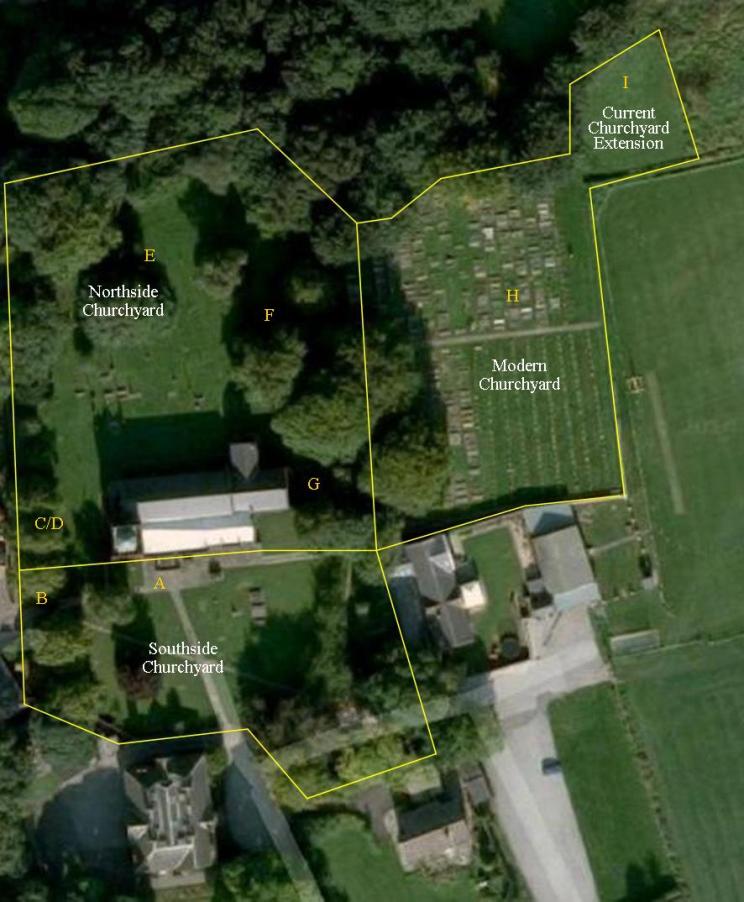The Churchyard |
Whiston Parish Church sits within a beautiful tree-lined churchyard. It is an open space that is accessible to all and is a popular destination not just for those seeking reflection; or to tend to the grave of a loved one; but also for dog-walkers and members of the local community who are just passing through. The earliest graves date from the 1730's and a new extension was consecrated by the Bishop of Sheffield (Rt Revd Dr Stephen Croft) on 16th June 2010; with the first burials on the new site coming in Autumn 2014. The churchyard is lovingly cared for all year round by a combination of volunteers from the congregation and local community, plus outside contractors. Lastly, it is also a natural habit for many species of plants and wildlife.
Use the map below to gain a better understanding of our churchyard. |

|
|
Key: |
|
A. Over the Door:
|
|
B. LychgateCompleted in 1919, the Lychgate serves as the parish memorial to those Whiston residents who fell in the two World Wars. The oak used in its construction was taken from the 15th Century bell frame that was removed from the tower in 1915. So parts of the Lychgate are in fact amongst the oldest items at Whiston Parish Church. |
|
C. The StocksThe old parish stocks are located to the north of the Lychgate and are situated just outside the churchyard boundary. When they were in use, they could accommodate up to three people at a time. One of the stone posts has the date 1768 inscribed on it, so this set of stocks dates from at least this period; again making them one of the oldest features not just in the churchyard, but possibly in the whole of Whiston. |
|
D. The Grave of Rebecca Cutt of Sheffield: died in 1736, aged 27 years.This is notable for its gravestone: a fine example of artisan craftsmanship, which is has a clear depiction of a skull and crossbones flanked by Doric columns and surmounted by vases. There is also an inscription for the visitor to read. it begins: "All you that come my grave to see / As I am now, so you must be; / Repent in time, make no delay / I in my prime was snatched away..." |
|
E. The Northside Churchyard; including First World World War (WWI) Graves.This part of the churchyard contains Victorian and Edwardian graves, plus two war graves. The latter are Private James of the Royal Munster Fusiliers - who died in 1915 aged 35 years; and Driver T. Waining of the Royal Field Artillery - who died in 1918 aged 18 years. |
|
F. Cremated Remains AreaThis area was established in loving memory of all whose ashes were laid to rest in the churchyard form the late 20th Century onwards. There is a central marker stone with a plain cross carved on it and, additionally, on the north wall of the churchyard, there are two headstones showing the names of the people who have cremated remains in the new cremation burial area. There is also now a bench seat and a boxed hedge to mark out this area of the churchyard. |
|
G. Old Cremated Remains AreaThis is the original cremated remains area. It was established in the 1970's and is now full to capacity. A Book of Remembrance may be found in the church by the Lady Chapel Altar. |
|
H. Present ChurchyardThis area contains graves from the 1930's to the present day. The final burials in this area took place in Summer 2014. |
|
I. New Churchyard ExtensionThis area was consecrated by Dr Stephen Croft - Bishop of Sheffield, on 16th June 2010. It means there is burial space within the churchyard for generations to come. The first burials in this area took place in Autumn 2014. |
|
